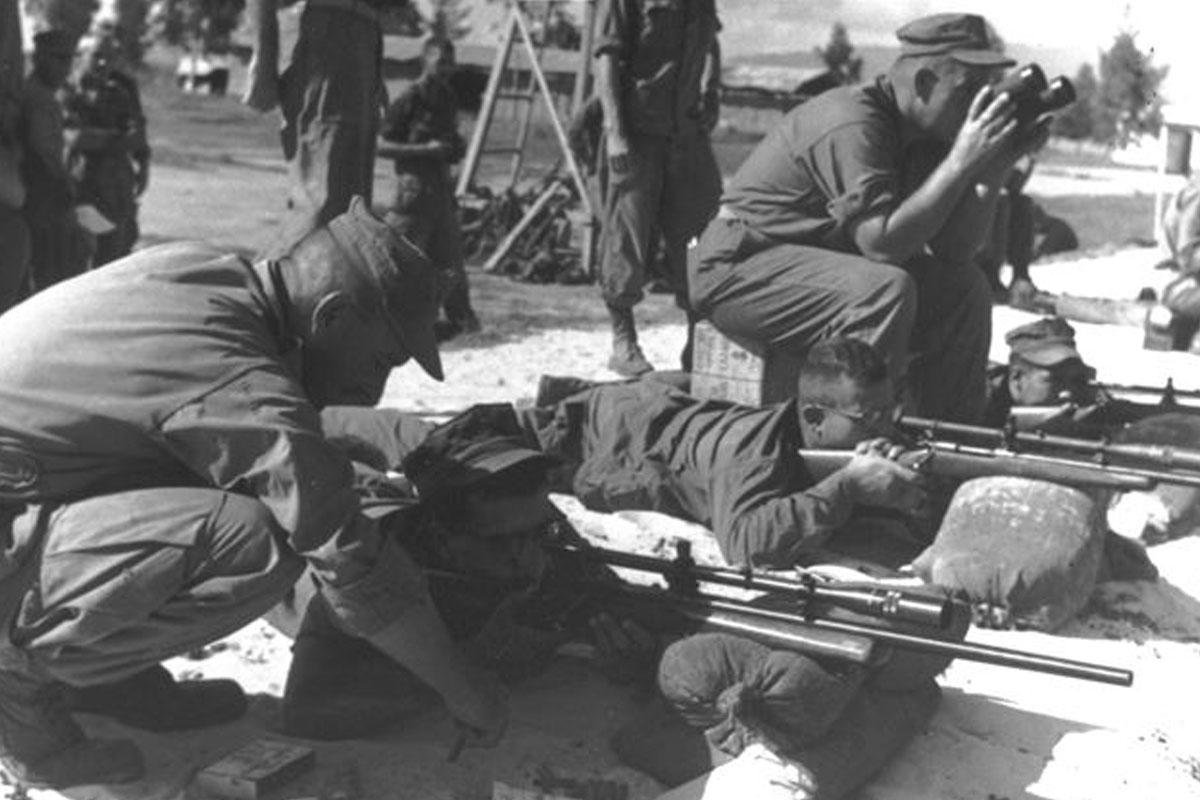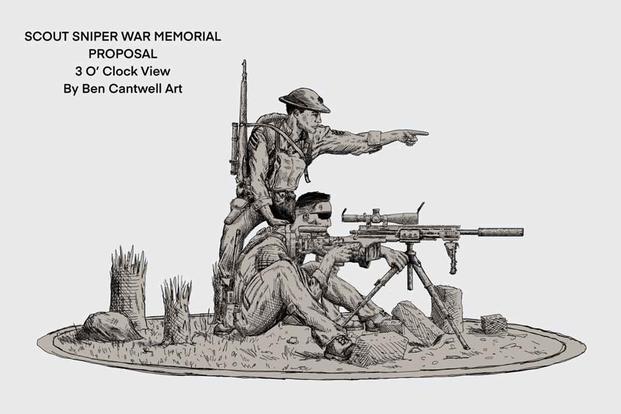
The Marine Scout Sniper War Memorial will look something like this: a bronze World War I observer, with an iconic brimmed helmet and a specialized Winchester rifle slung over his shoulder, points ahead. His hand rests on the shoulder of a Marine sniper with a high fade haircut, Oakley-style glasses and an M40A6 rifle, emblematic of those who served during the Global War on Terror.
They are both hunting a target, looking toward a future that has yet to be written. Yet they bookend the 105-year history of one of the military’s most storied and elite occupations, the Marine scout sniper.
In the summer of 2021, two years before the Corps axed the current iteration of the job, members of the Marine scout sniper community saw a growing need to preserve and catalog their heritage, one that is legendary but largely untold.
That is something that Tim Parkhurst and the Marine Scout Sniper Heritage Foundation hope to rectify as they seek to establish a first-of-its-kind memorial for generations of the community to call a place of reverence.
“The mission of the organization doesn’t stop with the memorial,” Parkhurst, president of the foundation and a retired Marine master sergeant, told Military.com in an interview Wednesday. “One of our responsibilities is to uncover that lost history of Marine scout snipers that literally has been lost.”

That history is often marked by moments, battles or the legendary men who took up the job’s purpose, such as the late retired Gunnery Sgt. Carlos Hathcock, a Marine sniper who racked up 93 confirmed kills during the Vietnam War. But its continuum — the beginning-to-end history that is common in other storied military jobs — has never been fully cataloged.
According to Parkhurst, that is due to a generational loss of knowledge induced — in part — by an administrative pipeline that does not favor continuity and a historical tendency by the Marine Corps to sideline snipers after major conflicts.
“That’s the thing, it’s an HR nightmare,” Parkhurst said. “We were never a primary duty. We never had a career path of our own.”
For decades, the scout sniper job was an additional military occupational specialty, or MOS, meaning that — administratively — it came second to whatever primary job the Marine held. Marines who became scout snipers after attending the course would spend tours within the specialty platoon, but then get farmed off to other positions that aligned with their primary job.
It also means that the Marine Corps system, which has “monitors” to assign Marines based on their primary MOS, didn’t prioritize the scout sniper position.
Parkhurst said it was common that, after experiencing the thrill and challenge of being a scout sniper, Marines would leave the service when faced with having to go back to whatever their primary duties were.
“How many guys were just like, ‘Screw that, I’m gone,’ and they go try to find greener pastures on the other side of the fence?” Parkhurst said.
On top of that, the scout sniper position is an enlisted one. Officers attended a course intended to teach them how to employ the asset, but as decision-makers who might spend only a brief time in the sniper platoon, they didn’t have an intimate knowledge of the job or how best to use it, Parkhurst said.
Last of the Scout Snipers
At the end of last year, when the Marine Corps graduated its last class of scout snipers, Military.com interviewed several members of the community, some of whom shared that frustration. When asked whether that lack of understanding morphed into a perception that the job was unimportant, Parkhurst agreed.
“That’s a correct conclusion,” he said. “And it’s been like that for decades. It’s not a recent thing, and it’s not something that only occurred back in the old days. It’s been a systemic problem.”
The lack of understanding, frequent turnover and apparent tokenism of the job resulted in an institutional knowledge drain, one catalyzed by a century-long trend of needing the asset when conflict started and then setting it aside when the bullets stopped flying.
“What we’re finding is that in every era of conflict — from World War I to World War II to Korea to Vietnam and the more recent War on Terror — there was, at some point, enough interest because of the looming conflict at hand, that the powers-that-be decided there needed to be a sniper capability, a scout sniper capability,” Parkhurst said.
But, as demonstrated during the withdrawal from Afghanistan, where Marine scout snipers played an integral role in the evacuation of Kabul, a “peacetime” military brought change. As the greater defense apparatus began shifting in earnest to its “pacing threat” — China — in the Pacific, the Marine Corps restructured itself under an initiative called Force Design, beginning in 2019.
So, out went tanks, some artillery, and the Marine Corps scout sniper MOS, among other positions. But in Parkhurst’s estimation — and other former scout snipers Military.com has spoken to — that won’t be the case forever.
“When it comes time to start slashing things at the end of the conflict, it’s not a surprise that they’re going to at least cut our numbers or at least downsize the program,” Parkhurst said. “But what’s kind of unconscionable in my mind, and it leaves us all scratching our heads, [is] we’ve got 105 years of history that shows that they want to bring us back every single time the shooting starts again.”
The Corps maintains that sniper weapons and marksmen will be “sustained” within infantry units and other specialized entities, but not in the same way as they once were, to include trading the coveted 0317 MOS — Scout Sniper — for the 0322 Reconnaissance Sniper title.
“As planned, the Marine Corps deactivated the Scout Sniper Instructor Course in November 2023, and has graduated the final class of Marines from the Basic Scout Sniper Course this month,” Maj. Joshua Pena told Military.com in December. “Though the graduates of this course will not be receiving the 0317 MOS, they will play a vital role of ensuring infantry battalions retain scouting and precision marksmanship capabilities while the training and curriculum necessary to meet fleet requirements [are] finalized and approved.”
Before those changes came to fruition, the Marine Scout Sniper Heritage Foundation began working on the scout sniper war memorial concept. The bronze sculpture designed by Sabin Howard, who recently completed his work on the National World War I Memorial to be unveiled in September, will stand 11 feet tall.
And pending some conceptual changes to the statue, the foundation hopes to have it completed in the next couple of years — but that timeline will come down to funding.
Working in conjunction with the Marine Corps Heritage Foundation, which oversees the Marine Corps Museum in Virginia, as a subsidiary of the Scout Sniper Association, Parkhurst and his team have begun the hard work of raising roughly $5 million for the project.
Parkhurst said that he visited the space where the memorial is planned to go in the Semper Fidelis Memorial Park outside of the museum last week. The foundation posted on social media Friday, writing that “the brave men who have served behind the long gun, and paid the ultimate sacrifice for our freedom, deserve nothing less!”
The fundraising goal not only contributes to the war memorial itself, but the research it will take to flesh out the true history of the Marine scout sniper.
Unearthing Sniper History
While some of the more famous Hollywood interpretations of the job have come from the Vietnam and GWOT eras, Marine scout snipers have their roots in World War I when Gen. John “Black Jack” Pershing, the commander of the American Expeditionary Forces, ordered infantry units to billet eight snipers per company, according to the foundation’s research.
By 1918, the military established a scout sniper school alongside other jobs, such as machine gunnery, and more than 400 service members were trained as snipers, an effort that was bolstered during World War II to combat German marksmen.
“No one at any schoolhouse for Marine scout snipers has ever taught that we had scout snipers in World War I,” Parkhurst said. “Occasionally, some individuals may have mentioned that we had scout snipers in World War II, but if they did, they were unable or just failed to produce any documentation that showed what that program looked like.”
It is the foundation’s aim to capture that legacy not only in the history books to educate the public — and Marines — about the scout sniper’s historical efforts, but also in the imagery that the memorial hopes to convey.
“The positioning of the figures is intended to evoke the symbolism every Marine is familiar with in the cake-cutting ceremony of the Marine Corps birthday celebration, where the oldest Marine passes knowledge and experience to the younger generation,” a document from the foundation said.
Parkhurst said that, along with donations, sales of commemorative bricks that will be laid near the memorial and from the foundation’s online store, he is looking for more help to make the project a reality — and for people to spread the word.
“We need all the help we can get fundraising,” Parkhurst said. “One of the specific things that I am asking for people to understand is that we all walk in different circles. I’m just a dumb grunt; I only know the people that I know. I don’t know anybody that particularly has a lot of money, and I’m not that well-connected. … So, anybody that’s willing to introduce us to someone who can make connections is greatly appreciated.”
Related: Into the History Books: Last Marine Corps Scout Snipers Graduate amid Service’s Planned Redesign
